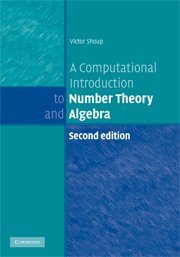Book contents
- Frontmatter
- Contents
- Preface
- Preliminaries
- 1 Basic properties of the integers
- 2 Congruences
- 3 Computing with large integers
- 4 Euclid's algorithm
- 5 The distribution of primes
- 6 Abelian groups
- 7 Rings
- 8 Finite and discrete probability distributions
- 9 Probabilistic algorithms
- 10 Probabilistic primality testing
- 11 Finding generators and discrete logarithms in ℤ*p
- 12 Quadratic reciprocity and computing modular square roots
- 13 Modules and vector spaces
- 14 Matrices
- 15 Subexponential-time discrete logarithms and factoring
- 16 More rings
- 17 Polynomial arithmetic and applications
- 18 Linearly generated sequences and applications
- 19 Finite fields
- 20 Algorithms for finite fields
- 21 Deterministic primality testing
- Appendix: Some useful facts
- Bibliography
- Index of notation
- Index
12 - Quadratic reciprocity and computing modular square roots
Published online by Cambridge University Press: 05 February 2015
- Frontmatter
- Contents
- Preface
- Preliminaries
- 1 Basic properties of the integers
- 2 Congruences
- 3 Computing with large integers
- 4 Euclid's algorithm
- 5 The distribution of primes
- 6 Abelian groups
- 7 Rings
- 8 Finite and discrete probability distributions
- 9 Probabilistic algorithms
- 10 Probabilistic primality testing
- 11 Finding generators and discrete logarithms in ℤ*p
- 12 Quadratic reciprocity and computing modular square roots
- 13 Modules and vector spaces
- 14 Matrices
- 15 Subexponential-time discrete logarithms and factoring
- 16 More rings
- 17 Polynomial arithmetic and applications
- 18 Linearly generated sequences and applications
- 19 Finite fields
- 20 Algorithms for finite fields
- 21 Deterministic primality testing
- Appendix: Some useful facts
- Bibliography
- Index of notation
- Index
Summary
In §2.8, we initiated an investigation of quadratic residues. This chapter continues this investigation. Recall that an integer a is called a quadratic residue modulo a positive integer n if gcd(a, n) = 1 and a ≡ b2 (mod n) for some integer b.
First, we derive the famous law of quadratic reciprocity. This law, while historically important for reasons of pure mathematical interest, also has important computational applications, including a fast algorithm for testing if an integer is a quadratic residue modulo a prime.
Second, we investigate the problem of computing modular square roots: given a quadratic residue a modulo n, compute an integer b such that a ≡ b2 (mod n). As we will see, there are efficient probabilistic algorithms for this problem when n is prime, and more generally, when the factorization of n into primes is known.
The Legendre symbol
For an odd prime p and an integer a with gcd(a, p) = 1, the Legendre symbol (a | p) is defined to be 1 if a is a quadratic residue modulo p, and −1 otherwise. For completeness, one defines (a | p) = 0 if p | a. The following theorem summarizes the essential properties of the Legendre symbol.
Information
- Type
- Chapter
- Information
- A Computational Introduction to Number Theory and Algebra , pp. 342 - 357Publisher: Cambridge University PressPrint publication year: 2008
